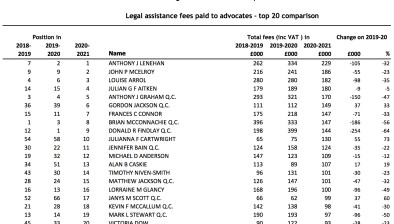Signs of legal aid recovery as applications, grants and payments rise – but reform needed

Colin Lancaster
There was a significant recovery in most areas of legal aid activity in 2021-22 following the substantial drop the previous year, according to the annual report of the Scottish Legal Aid Board (SLAB).
The total cost to the taxpayer of providing legal assistance was £118.2 million in 2021-22.
The publication today of the annual report for 2021-22 shows this was a 19 per cent increase on the previous year’s cost of £99.1m. Total payments were still 10 per cent below the amount paid in the pre-pandemic year of 2019-20, but the ongoing pace of the court recovery programme meant that by the end of the year weekly payments for most case types were at or above pre-pandemic levels.
The partial recovery in expenditure has been driven primarily by a 29 per cent increase in the cost of criminal legal assistance to £62.5 million.
Expenditure on solemn criminal legal aid rose 49 per cent to £29 million and expenditure on summary criminal legal aid rose 30 per cent to £21 million.
There was an eight per cent increase in net civil legal assistance expenditure on the previous year. Civil legal assistance continues to be dominated by family disputes which accounted for 56 per cent of net expenditure.
There were significant increases in net expenditure on contact cases (21 per cent) and residence cases (25 per cent). In non-family cases, those involving adults with incapacity saw a 26 per cent increase in net expenditure.
Consistent with wider criminal justice trends, summary criminal cases were higher than in 2020-21 but remained below pre-pandemic levels, while solemn legal aid was significantly higher than pre-pandemic for the second year running.
Driven partly by the highest ever number of adults with incapacity cases, the number of civil legal aid grants was also higher than the long term average, while continued protection in relation to housing debt meant demand for housing advice and representation remained very low.
Colin Lancaster, chief executive of SLAB, welcomed the increase in activity levels but said huge challenges still lay ahead for the justice system in clearing the backlog of court cases caused by Covid-19.
He said signs of recovery can be seen in the levels of payments made to solicitors, many of whose finances will have been hit by the combination of almost a decade of reducing business volumes followed by the massive disruption brought about by the pandemic.
“As a reflection of the ongoing recovery in the wider justice system, the increase in payments to legal aid firms compared to 2020-21 is welcome,” he said.
But on the issue of longer term sustainability, Mr Lancaster observed that the legal aid system and delivery model are fundamentally unaltered from the 1950s and so have not evolved to fully reflect societal changes over the decades.
He said: “It is perhaps unsurprising in this context that the profession finds itself struggling with some of the mismatches between the way they are structured and operate, the strictures of the legal aid system, and the wider world in which both exist but perhaps no longer adequately reflect.”
He added that the focus on fees, both structures and levels, are just one part of a complex range of factors, trends and interactions that impact on the financial return, sustainability and suitability of one particular model for the delivery of this public service.
“That model is at the core of the current legal aid system, but alongside the challenges faced by those delivering the service, the system is itself in urgent need of reform,” he said.
“It is overly complex, elements of it can be confusing and time-consuming for both applicants and solicitors and for SLAB to deliver; and this complexity makes aspects of it more costly to administer than need be.”
Mr Lancaster said any solution that hopes to build a sustainable future for the legal aid system and those who deliver the services it supports has to address this complexity.
“As explored in the Scottish government’s 2019 consultation on legal aid reform, there is massive potential for a more person-centred model, designed around the needs of users to deliver easier access to a wider range of services, directed towards positive outcomes for individuals, communities and the justice system.”









